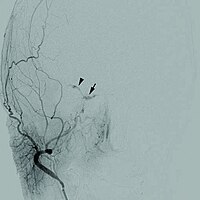
Association Between Idiopathic Intracranial Hypertension and Risk of Cardiovascular Diseases in Women in the United Kingdom
Sign Up to like & getrecommendations! Published in 2019 at "JAMA Neurology"
DOI: 10.1001/jamaneurol.2019.1812
Abstract: Key Points Question Is the risk of cardiovascular disease greater in women with idiopathic intracranial hypertension than in women of the same age and body mass index but without idiopathic intracranial hypertension? Findings In this… read more here.
Keywords: cardiovascular disease; risk cardiovascular; idiopathic intracranial; intracranial hypertension ... See more keywords

Evaluation of Outcomes Among Patients With Traumatic Intracranial Hypertension Treated With Decompressive Craniectomy vs Standard Medical Care at 24 Months: A Secondary Analysis of the RESCUEicp Randomized Clinical Trial.
Sign Up to like & getrecommendations! Published in 2022 at "JAMA neurology"
DOI: 10.1001/jamaneurol.2022.1070
Abstract: Importance Trials often assess primary outcomes of traumatic brain injury at 6 months. Longer-term data are needed to assess outcomes for patients receiving surgical vs medical treatment for traumatic intracranial hypertension. Objective To evaluate 24-month… read more here.
Keywords: hypertension; disability; traumatic intracranial; patients traumatic ... See more keywords

Incidence of Idiopathic Intracranial Hypertension in Individuals With Gonadotropin-Releasing Hormone Analogue Treatment for Gender Dysphoria in Sweden.
Sign Up to like & getrecommendations! Published in 2023 at "JAMA pediatrics"
DOI: 10.1001/jamapediatrics.2023.0656
Abstract: This cohort study examines the incidence of idiopathic intracranial hypertension (IHH) among individuals in Sweden undergoing gonadotropin-releasing hormone analogue (GnRHa) treatment for gender dysphoria. read more here.
Keywords: releasing hormone; gonadotropin releasing; idiopathic intracranial; hormone analogue ... See more keywords

Periventricular white matter changes in idiopathic intracranial hypertension
Sign Up to like & getrecommendations! Published in 2019 at "Annals of Clinical and Translational Neurology"
DOI: 10.1002/acn3.685
Abstract: To evaluate whether increased cerebrospinal fluid (CSF) pressure causes alteration of periventricular white matter (WM) microstructure in patients with idiopathic intracranial hypertension (IIH). read more here.
Keywords: idiopathic intracranial; periventricular white; intracranial hypertension; white matter ... See more keywords

Venous Stenting for Idiopathic Intracranial Hypertension
Sign Up to like & getrecommendations! Published in 2019 at "Neuro-Ophthalmology"
DOI: 10.1007/978-3-319-98455-1_7
Abstract: Idiopathic intracranial hypertension is a syndrome affecting mostly obese women of childbearing age leading to symptoms and signs of elevated intracranial pressure including papilledema. Management includes weight loss and medications that reduce intracranial pressure, but… read more here.
Keywords: intracranial hypertension; idiopathic intracranial; ophthalmology; stenting idiopathic ... See more keywords

Long-term Kinetic Papilledema Improvement After Venous Sinus Stenting in Idiopathic Intracranial Hypertension
Sign Up to like & getrecommendations! Published in 2020 at "Clinical Neuroradiology"
DOI: 10.1007/s00062-020-00908-z
Abstract: Background and Purpose The aim of this study was to assess the safety and effectiveness of lateral sinus stenosis (LSS) stenting in patients with idiopathic intracranial hypertension (IIH) who are refractory to medical treatment, particularly… read more here.
Keywords: sinus; lss stenting; idiopathic intracranial; intracranial hypertension ... See more keywords

Brain herniation (encephalocele) into arachnoid granulations: prevalence and association with pulsatile tinnitus and idiopathic intracranial hypertension
Sign Up to like & getrecommendations! Published in 2022 at "Neuroradiology"
DOI: 10.1007/s00234-022-02934-9
Abstract: Brain herniation into arachnoid granulations (BHAG) of the dural venous sinuses is a recently described finding of uncertain etiology. The purpose of this study was to investigate the prevalence of BHAG in a cohort of… read more here.
Keywords: idiopathic intracranial; arachnoid granulations; intracranial hypertension; brain herniation ... See more keywords

Lack of association of cranial lacunae with intracranial hypertension in children with Crouzon syndrome and Apert syndrome: a 3D morphometric quantitative analysis
Sign Up to like & getrecommendations! Published in 2019 at "Child's Nervous System"
DOI: 10.1007/s00381-019-04059-6
Abstract: PurposeCranial lacunae (foci of attenuated calvarial bone) are CT equivalents of “copper beating” seen on plain skull radiographs in children with craniosynostosis. The qualitative presence of copper beating has not been found to be useful… read more here.
Keywords: lacunae; intracranial hypertension; cranial lacunae; syndrome apert ... See more keywords

GAPO syndrome with craniosynostosis and intracranial hypertension
Sign Up to like & getrecommendations! Published in 2019 at "Child's Nervous System"
DOI: 10.1007/s00381-019-04250-9
Abstract: BackgroundGAPO (growth retardation, alopecia, pseudoanodontia, and optic atrophy) as a rare genetic disorder includes growth retardation, alopecia, pseudoanodontia, and optic atrophy. It was reported to be associated with craniosynostosis and intracranial hypertension.Case ReportA patient with… read more here.
Keywords: craniosynostosis intracranial; gapo syndrome; intracranial hypertension; craniosynostosis ... See more keywords

Emerging themes in idiopathic intracranial hypertension
Sign Up to like & getrecommendations! Published in 2020 at "Journal of Neurology"
DOI: 10.1007/s00415-020-10090-4
Abstract: Idiopathic intracranial hypertension (IIH) is a rare disorder characterised by raised intracranial pressure. The underlying pathophysiology is mostly unknown and effective treatment is an unmet clinical need in this disease. This review evaluates key emerging… read more here.
Keywords: intracranial hypertension; themes idiopathic; idiopathic intracranial; emerging themes ... See more keywords

External cranial expansion as treatment of intracranial hypertension. Technical note
Sign Up to like & getrecommendations! Published in 2021 at "Neurosurgical Review"
DOI: 10.1007/s10143-021-01571-9
Abstract: Intracranial hypertension may be idiopathic or due to multiple etiologies. Some bone dysplasias and chronic shunt overdrainage syndrome may sometimes lead to intracranial hypertension associated with craniocerebral disproportion due to thickening of cranial diploe. The… read more here.
Keywords: external cranial; intracranial hypertension; hypertension; cranial expansion ... See more keywords